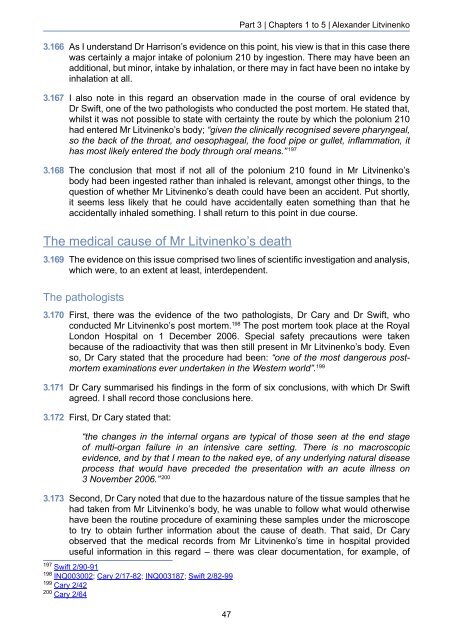The Litvinenko Inquiry
JIEp7Zyr
JIEp7Zyr
You also want an ePaper? Increase the reach of your titles
YUMPU automatically turns print PDFs into web optimized ePapers that Google loves.
Part 3 | Chapters 1 to 5 | Alexander <strong>Litvinenko</strong><br />
3.166 As I understand Dr Harrison’s evidence on this point, his view is that in this case there<br />
was certainly a major intake of polonium 210 by ingestion. <strong>The</strong>re may have been an<br />
additional, but minor, intake by inhalation, or there may in fact have been no intake by<br />
inhalation at all.<br />
3.167 I also note in this regard an observation made in the course of oral evidence by<br />
Dr Swift, one of the two pathologists who conducted the post mortem. He stated that,<br />
whilst it was not possible to state with certainty the route by which the polonium 210<br />
had entered Mr <strong>Litvinenko</strong>’s body; “given the clinically recognised severe pharyngeal,<br />
so the back of the throat, and oesophageal, the food pipe or gullet, inflammation, it<br />
has most likely entered the body through oral means.” 197<br />
3.168 <strong>The</strong> conclusion that most if not all of the polonium 210 found in Mr <strong>Litvinenko</strong>’s<br />
body had been ingested rather than inhaled is relevant, amongst other things, to the<br />
question of whether Mr <strong>Litvinenko</strong>’s death could have been an accident. Put shortly,<br />
it seems less likely that he could have accidentally eaten something than that he<br />
accidentally inhaled something. I shall return to this point in due course.<br />
<strong>The</strong> medical cause of Mr <strong>Litvinenko</strong>’s death<br />
3.169 <strong>The</strong> evidence on this issue comprised two lines of scientific investigation and analysis,<br />
which were, to an extent at least, interdependent.<br />
<strong>The</strong> pathologists<br />
3.170 First, there was the evidence of the two pathologists, Dr Cary and Dr Swift, who<br />
conducted Mr <strong>Litvinenko</strong>’s post mortem. 198 <strong>The</strong> post mortem took place at the Royal<br />
London Hospital on 1 December 2006. Special safety precautions were taken<br />
because of the radioactivity that was then still present in Mr <strong>Litvinenko</strong>’s body. Even<br />
so, Dr Cary stated that the procedure had been: “one of the most dangerous postmortem<br />
examinations ever undertaken in the Western world”. 199<br />
3.171 Dr Cary summarised his findings in the form of six conclusions, with which Dr Swift<br />
agreed. I shall record those conclusions here.<br />
3.172 First, Dr Cary stated that:<br />
“the changes in the internal organs are typical of those seen at the end stage<br />
of multi-organ failure in an intensive care setting. <strong>The</strong>re is no macroscopic<br />
evidence, and by that I mean to the naked eye, of any underlying natural disease<br />
process that would have preceded the presentation with an acute illness on<br />
3 November 2006.” 200<br />
3.173 Second, Dr Cary noted that due to the hazardous nature of the tissue samples that he<br />
had taken from Mr <strong>Litvinenko</strong>’s body, he was unable to follow what would otherwise<br />
have been the routine procedure of examining these samples under the microscope<br />
to try to obtain further information about the cause of death. That said, Dr Cary<br />
observed that the medical records from Mr <strong>Litvinenko</strong>’s time in hospital provided<br />
useful information in this regard – there was clear documentation, for example, of<br />
197<br />
Swift 2/90-91<br />
198<br />
INQ003002; Cary 2/17-82; INQ003187; Swift 2/82-99<br />
199<br />
Cary 2/42<br />
200<br />
Cary 2/64<br />
47


